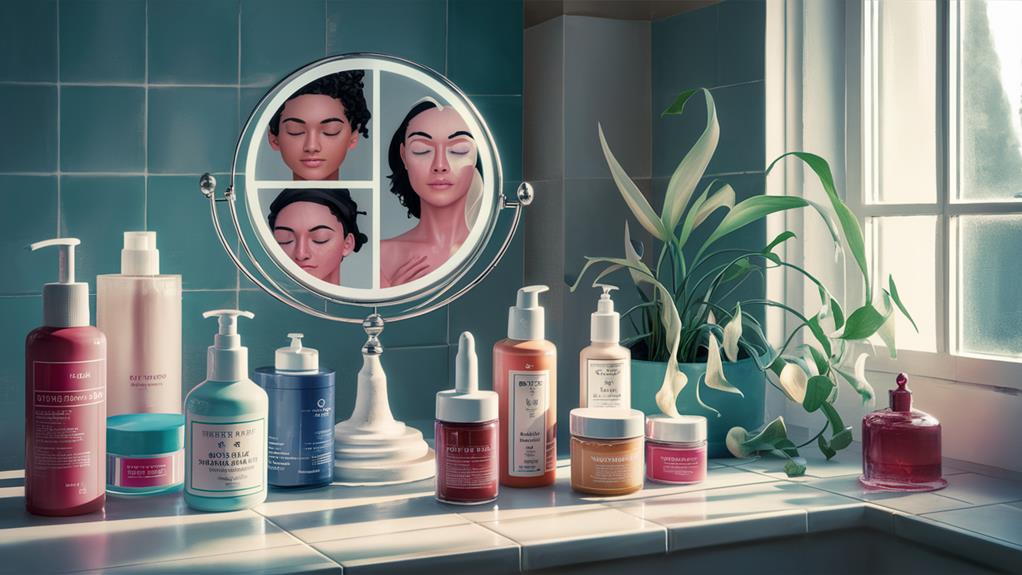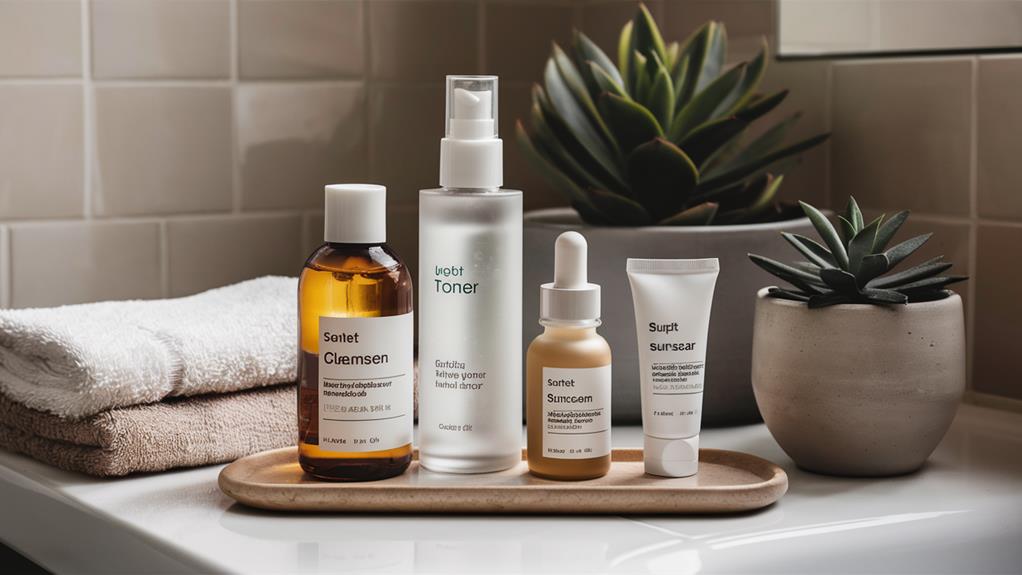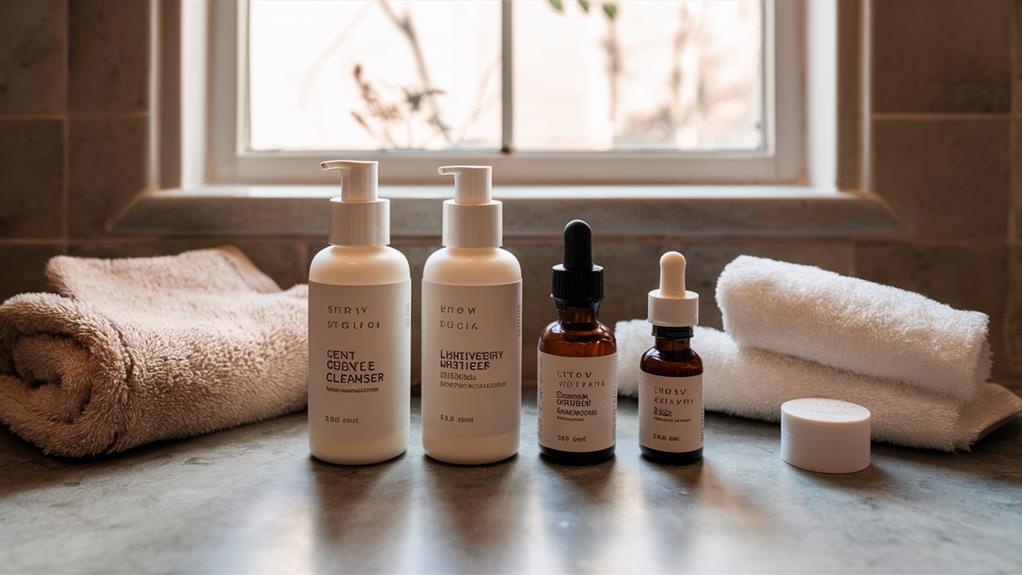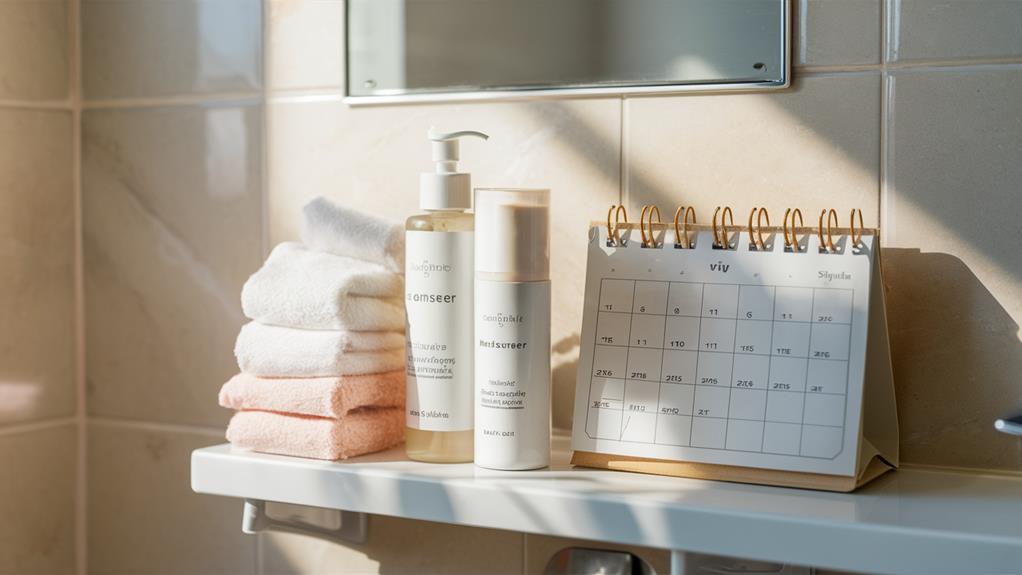Creating a simple skincare routine begins with identifying your skin type—oily, dry, combination, sensitive, or normal. Next, cleanse your face twice daily with a gentle cleanser suited for your skin. Follow up with a hydrating moisturizer to lock in moisture, applying it when your skin is slightly damp. Don't forget daily sun protection; a broad-spectrum SPF is essential for preventing UV damage. To maintain consistency, set a schedule and keep products in sight. Your routine can evolve, so be flexible and adjust as your skin's needs change. With these basics, you'll be well on your way to healthy skin. More insights await!
Key Takeaways
- Identify your skin type (oily, dry, combination, sensitive, normal) to choose suitable products for your routine.
- Start with a gentle cleanser to remove impurities and cleanse your skin twice daily.
- Apply a hydrating moisturizer to lock in moisture, especially after cleansing.
- Use broad-spectrum SPF daily to protect your skin from UV damage and premature aging.
- Keep your routine consistent by scheduling it, tracking progress, and making seasonal adjustments as needed.
Understanding Your Skin Type

Understanding your skin type is essential for developing an effective skincare routine that meets your unique needs. Each skin type has specific characteristics that influence how it reacts to products and environmental factors. The main skin types include oily, dry, combination, sensitive, and normal.
By identifying your skin type, you can choose products that work harmoniously with your skin, enhancing its natural beauty. For example, many eco-friendly products, such as plant-based detergents, can be beneficial for sensitive skin, as they often contain natural ingredients that reduce irritation.
To determine your skin type, pay attention to how your skin feels throughout the day. Oily skin tends to look shiny, especially in the T-zone, while dry skin may feel tight or flaky. Combination skin often exhibits both oily and dry areas, whereas sensitive skin might react with redness or irritation to certain products. Normal skin typically maintains a balanced, healthy appearance.
Don't forget about seasonal adjustments, either. Your skin can change with the seasons, requiring you to adapt your routine. For instance, cold weather can lead to dryness, while heat and humidity might amplify oiliness.
As you shift through the seasons, monitor your skin's behavior and alter your products accordingly.
Essential Skincare Steps

Once you've identified your skin type, it's time to establish a skincare routine that addresses its specific needs. A successful routine hinges on three vital steps: cleansing, moisturizing, and protecting. By following these steps, you'll create a foundation that nurtures your skin and promotes its health.
Additionally, consider enhancing your environment with calming elements, such as an essential oil diffuser, which can create a soothing atmosphere while you care for your skin.
- Cleansing Techniques: Start with a gentle cleanser suitable for your skin type. For oily skin, look for foaming cleansers that remove excess oil. If you have dry skin, opt for cream-based cleansers that hydrate while they cleanse. Aim to cleanse your face twice daily—once in the morning and once before bed.
- Moisturizing Basics: After cleansing, the next step is moisturizing. Regardless of your skin type, moisturizing is vital. For oily skin, lightweight, oil-free moisturizers can hydrate without clogging pores. For dry skin, richer creams with ingredients like hyaluronic acid will help retain moisture. Apply your moisturizer while your skin is still slightly damp to lock in hydration.
- Sun Protection: Finally, don't skip sunscreen during the day. A broad-spectrum SPF protects your skin from harmful UV rays and prevents premature aging.
Recommended Products for Beginners

When starting your skincare journey, selecting the right products can make all the difference. As a beginner, you want products that are effective yet gentle on your skin. Look for cleansers, moisturizers, and serums that feature natural ingredients, as they're often less irritating and more nourishing.
Additionally, ensuring a clean indoor environment can support skin health, making air purifiers beneficial for reducing allergens and pollutants that may affect your skin improve indoor air quality.
For your cleanser, consider a gentle gel or cream formula, ideally with soothing ingredients like chamomile or aloe vera. These budget-friendly options will cleanse without stripping your skin's natural oils.
Next, a hydrating moisturizer is vital. Opt for one that includes hyaluronic acid or glycerin—both are excellent at attracting moisture to your skin. If you have oily skin, a lightweight lotion will keep your skin feeling fresh without clogging your pores.
For added benefits, incorporating a serum can elevate your routine. Look for serums with antioxidants like vitamin C, which help brighten your complexion and protect against environmental damage. Many brands offer budget-friendly options packed with natural ingredients, making it easier to find something that suits your needs.
Lastly, don't forget sunscreen. A broad-spectrum SPF is essential, even on cloudy days. Look for formulations that are lightweight and non-greasy, so they don't feel heavy on your skin.
Tips for Consistency

Staying consistent with your skincare routine is essential for achieving the results you desire. Establishing a regular regimen can be challenging, but with the right motivation strategies and habit formation techniques, you'll find it easier to stick with it.
Here are some practical tips to help you maintain consistency:
- Create a Schedule: Set aside specific times each day to perform your skincare routine. Treat it like an important appointment that you can't miss.
- Keep Your Products Visible: Store your skincare products in a place where you'll see them regularly, like on your bathroom counter. This visual reminder can help reinforce your habit.
- Pair With Another Routine: Integrate your skincare routine with an existing habit, like brushing your teeth in the morning and evening. This connection can make it feel more natural and less like a chore.
Adjusting Your Routine Over Time

Flexibility is key to maintaining an effective skincare routine, as your skin's needs can change over time due to factors like age, climate, and lifestyle. To guarantee your routine continues to serve you well, it's important to regularly assess and adjust your products and practices.
Seasonal adjustments play a significant role in how your skin behaves. For instance, during the dry winter months, your skin may require a richer moisturizer to combat dryness, while in the summer, a lightweight gel moisturizer might be more appropriate to prevent excess oil.
Pay attention to how your skin reacts to changes in weather and adapt your routine accordingly.
Lifestyle influences also impact your skin's condition. If you're experiencing increased stress, lack of sleep, or dietary changes, you might notice breakouts or dullness. This is the perfect time to incorporate soothing ingredients like chamomile or aloe vera and perhaps reduce the frequency of harsh exfoliants.
Take a moment to evaluate your current routine every season or whenever you notice changes in your skin. Don't hesitate to experiment with new products or techniques that may better suit your needs.
Frequently Asked Questions
How Long Will It Take to See Results From My Skincare Routine?
When you start a skincare routine, you might wonder about the expected timeline for visible improvements.
Typically, you'll see some results within four to six weeks, especially with consistent use of products.
For deeper issues, like acne scars or hyperpigmentation, it can take up to three months or longer.
Everyone's skin is unique, so patience and consistency are key.
Celebrate small changes, as they build up to more significant results over time!
Can I Use Makeup While Following a Skincare Routine?
Can you wear makeup while sticking to a skincare routine? Absolutely!
Just guarantee that your makeup products are compatible with your skin type and the products in your routine. Opt for non-comedogenic and hydrating formulations to prevent breakouts and dryness.
Always apply your skincare first, allowing it to absorb properly before layering on makeup.
Is It Necessary to Use Sunscreen Every Day?
Yes, it's necessary to use sunscreen every day.
Daily application of sunscreen offers essential protection against harmful UV rays, reducing your risk of skin cancer and premature aging. The benefits of sunscreen extend beyond just preventing sunburn; it helps maintain an even skin tone and supports overall skin health.
What Should I Do if My Skin Reacts Negatively to a Product?
If your skin's suffering from product problems, don't panic!
First, stop using the product immediately to prevent further irritation.
Next, consider your ingredient sensitivity; identify any harsh components.
Patch testing new products on a small skin area before full application can save you from future frustrations.
Consult a dermatologist if reactions persist, as they can offer tailored advice.
How Often Should I Exfoliate My Skin?
Exfoliating your skin is essential, but you don't want to overdo it.
For most skin types, exfoliating two to three times a week is ideal. Daily exfoliation can irritate your skin, especially if you're using physical exfoliants, which can be too harsh.
Pay attention to how your skin reacts and adjust accordingly. Finding that balance will help you achieve a smoother, healthier complexion while keeping your skin happy and vibrant.
Conclusion
Creating a simple skincare routine is like planting a garden; with the right care and attention, your skin will flourish. By understanding your skin type and following essential steps, you'll set a solid foundation for healthy skin. Remember, consistency is key—stick to your routine like a favorite song on repeat. As you learn what works for you, don't hesitate to adjust your routine. With time and patience, your skin will reflect the effort you've invested.

